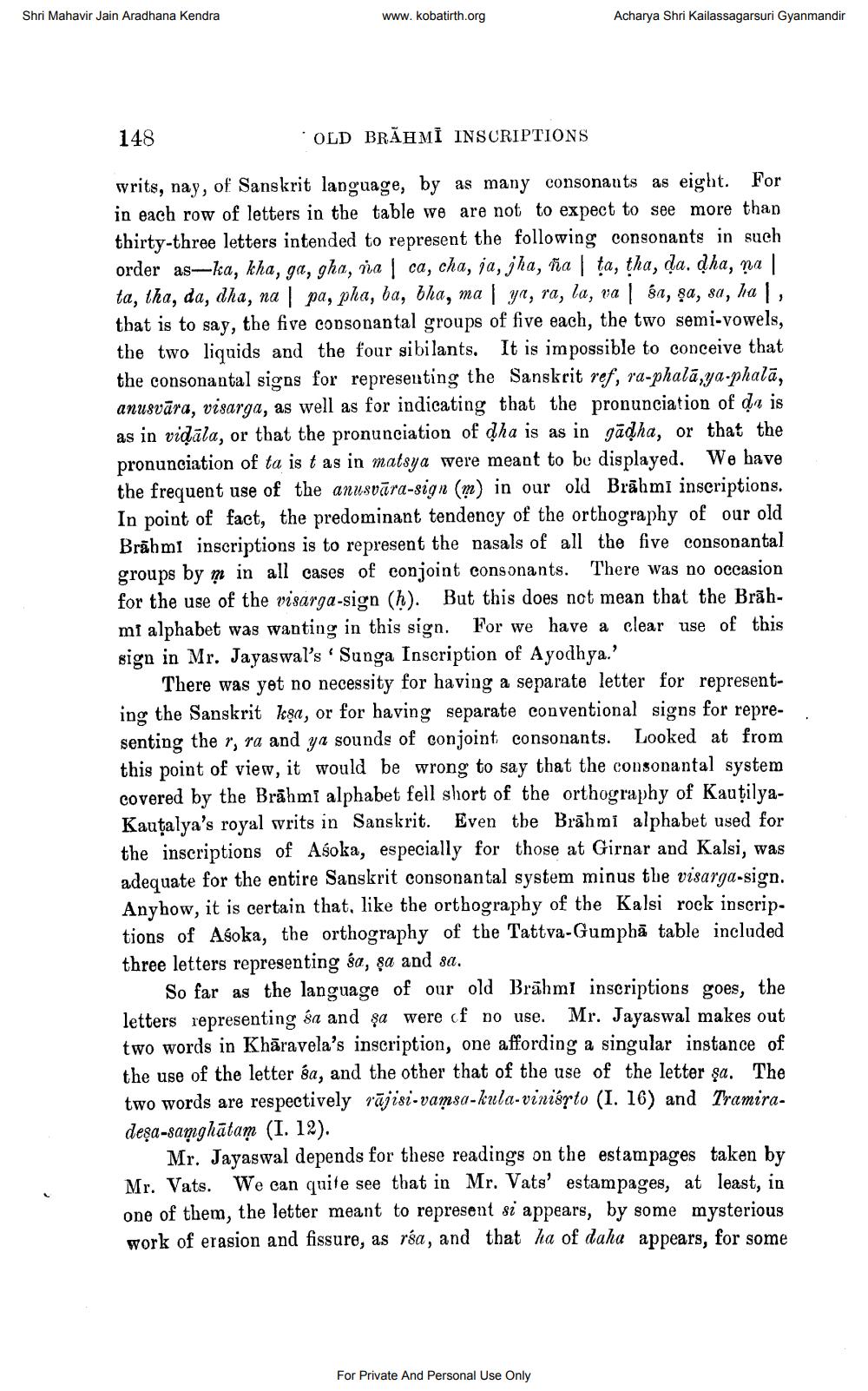________________
Shri Mahavir Jain Aradhana Kendra
www.kobatirth.org
Acharya Shri Kailassagarsuri Gyanmandir
148
OLD BRAHMI INSCRIPTIONS
writs, nay, of Sanskrit language, by as many consonants as eight. For in each row of letters in the table we are not to expect to see more than thirty-three letters intended to represent the following consonants in such order as-ka, kha, ga, gha, na ca, cha, ja, jha, ña ta, tha, da. dha, na ta, tha, da, dha, na pa, pha, ba, bha, ma | ya, ra, la, va sa, şa, sa, ha , that is to say, the five consonantal groups of five each, the two semi-vowels, the two liquids and the four sibilants. It is impossible to conceive that the consonantal signs for representing the Sanskrit ref, ra-phalā,ya-phalā, anusvāra, visarga, as well as for indicating that the pronunciation of da is as in vidala, or that the pronunciation of dha is as in gādha, or that the pronunciation of ta is t as in matsya were meant to be displayed. We have the frequent use of the anusvāra-sign (m) in our old Brāhmi inscriptions. In point of fact, the predominant tendency of the orthography of our old Brāhmi inscriptions is to represent the nasals of all the five consonantal groups by m in all cases of conjoint consonants. There was no occasion for the use of the visarga-sign (h). But this does not mean that the Brāhmi alphabet was wanting in this sign. For we have a clear use of this sign in Mr. Jayaswal's 'Sunga Inscription of Ayodhya.'
There was yet no necessity for having a separate letter for representing the Sanskrit kşa, or for having separate conventional signs for representing the r, ra and ya sounds of conjoint consonants. Looked at from this point of view, it would be wrong to say that the consonantal system covered by the Brähmi alphabet fell short of the orthography of KautilyaKautalya's royal writs in Sanskrit. Even the Brāhmi alphabet used for the inscriptions of Asoka, especially for those at Girnar and Kalsi, was adequate for the entire Sanskrit consonantal system minus the visarga-sign. Anyhow, it is certain that, like the orthography of the Kalsi rock inscriptions of Asoka, the orthography of the Tattva-Gumphā table included three letters representing sa, sa and sa.
So far as the language of our old Brāhmi inscriptions goes, the letters representing sa and şa were of no use. Mr. Jayaswal makes out two words in Khāravela's inscription, one affording a singular instance of the use of the letter sa, and the other that of the use of the letter şa. The two words are respectively rājisi-vamsa-kula-vinisrto (I. 16) and Tramiradeşa-samghātam (I. 12).
Mr. Jayaswal depends for these readings on the estampages taken by Mr. Vats. We can quite see that in Mr. Vats' estampages, at least, in one of them, the letter meant to represent si appears, by some mysterious work of erasion and fissure, as rúa, and that ha of daha appears, for some
For Private And Personal Use Only




